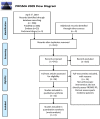PROMIS Versus Legacy Patient-Reported Outcome Measures for Sports Medicine Patients Undergoing Arthroscopic Knee, Shoulder, and Hip Interventions: A Systematic Review
- PMID: 34924871
- PMCID: PMC8662933
PROMIS Versus Legacy Patient-Reported Outcome Measures for Sports Medicine Patients Undergoing Arthroscopic Knee, Shoulder, and Hip Interventions: A Systematic Review
Abstract
Background: The Patient-Reported Outcomes Measurement Information System (PROMIS®) was designed to monitor the global wellbeing of patients, with the Physical Function Computer-Adaptive Test (PF-CAT) component focused specifically on functional outcome. PROMIS aims for increased item-bank accuracy, lower administrative burden, and decreased floor and ceiling effects compared to legacy patient-reported outcome measures (PROMs). Our primary research outcomes focused on sports medicine surgical populations, which may skew younger or have wide-ranging functional statuses. Specifically, for this population, we questioned if PROMIS PF-CAT was equal to legacy PROMs in (1) construct validity and (2) convergent/divergent validities; and superior to legacy PROMs with respect to (3) survey burden and (4) floor and ceiling effects.
Methods: Searches were performed in April 2019 in accordance with Preferred Reporting Items for Systematic Reviews and Meta-Analyses (PRISMA) guidelines, utilizing PubMed, Cochrane Central, and Embase databases for Level I-III evidence. This resulted in 541 records, yielding 12 studies for inclusion. PROM data was available for patients undergoing arthroscopic orthopaedic procedures of the knee, shoulder, and hip. Measures of construct validity, convergent/divergent validity, survey burden, and floor/ceiling effects were evaluated for PROMIS PF-CAT versus legacy PROMs.
Results: PROMIS PF-CAT demonstrated excellent or excellent-good correlation with legacy PROMS for physical function and quality of life for patients undergoing arthroscopic interventions of the knee, shoulder, and hip. Compared to legacy PROM instruments, PROMIS PF-CAT demonstrated the lowest overall survey burden and had the lowest overall number of floor or ceiling effects across participants.
Conclusion: PROMIS PF-CAT is an accurate, efficient evaluation tool for sports medicine surgical patients. PROMIS PF-CAT strongly correlates with legacy physical function PROMs while having a lower test burden and less incidence of floor and ceiling effects. PROMIS PF-CAT may be an optimal alternative for traditional physical function PROMs in sports medicine patients undergoing arthroscopic procedures. Further studies are required to extend the generalizability of these findings to patients during postoperative timepoints after shoulder and hip interventionsLevel of Evidence: III.
Keywords: hip arthroscopy; knee arthroscopy; outcomes-based research; patient-reported outcome measures; prom; promis; shoulder arthroscopy; sports medicine; systematic review.
Copyright © The Iowa Orthopaedic Journal 2021.
Figures
Similar articles
-
Relationship Between PROMIS Computer Adaptive Tests and Legacy Hip Measures Among Patients Presenting to a Tertiary Care Hip Preservation Center.Am J Sports Med. 2019 Mar;47(4):876-884. doi: 10.1177/0363546518825252. Epub 2019 Feb 12. Am J Sports Med. 2019. PMID: 30753105
-
The Impact of Workers' Compensation on Patient-Reported Outcomes Measurement Information System Upper Extremity and Legacy Outcome Measures in Patients Undergoing Arthroscopic Rotator Cuff Repair.Arthroscopy. 2019 Oct;35(10):2817-2824. doi: 10.1016/j.arthro.2019.05.027. Arthroscopy. 2019. PMID: 31604498
-
Patient-Reported Outcomes Measurement Information System Test Is Less Responsive Than Legacy Hip-Specific Patient-Reported Outcome Measures in Patients Undergoing Arthroscopy for Femoroacetabular Impingement Syndrome.Arthrosc Sports Med Rehabil. 2021 Aug 27;3(6):e1645-e1650. doi: 10.1016/j.asmr.2021.07.020. eCollection 2021 Dec. Arthrosc Sports Med Rehabil. 2021. PMID: 34977616 Free PMC article.
-
Patient-Reported Outcomes Measurement Information System Scores Are Inconsistently Correlated With Legacy Patient-Reported Outcome Measures in Shoulder Pathology: A Systematic Review.Arthroscopy. 2021 Apr;37(4):1301-1309.e1. doi: 10.1016/j.arthro.2020.11.039. Epub 2020 Nov 27. Arthroscopy. 2021. PMID: 33253797
-
What Are the Floor and Ceiling Effects of Patient-Reported Outcomes Measurement Information System Computer Adaptive Test Domains in Orthopaedic Patients? A Systematic Review.Arthroscopy. 2020 Mar;36(3):901-912.e7. doi: 10.1016/j.arthro.2019.09.022. Epub 2020 Jan 7. Arthroscopy. 2020. PMID: 31919023
Cited by
-
Translation and linguistic validation of 24 PROMIS item banks into French.Qual Life Res. 2024 Aug;33(8):2119-2127. doi: 10.1007/s11136-024-03690-4. Epub 2024 Jun 12. Qual Life Res. 2024. PMID: 38865068 Free PMC article.
-
Responsiveness and minimal important change of seven PROMIS computerized adaptive tests (CAT) in patients with advanced chronic kidney disease.J Patient Rep Outcomes. 2023 Apr 4;7(1):35. doi: 10.1186/s41687-023-00574-y. J Patient Rep Outcomes. 2023. PMID: 37016107 Free PMC article.
-
Relationships Between PROMIS and Legacy Patient-Reported Outcome Measure (PROM) Scores in the MARS Cohort at 10-Year Follow-up.J Bone Joint Surg Am. 2025 May 7;107(9):985-993. doi: 10.2106/JBJS.24.00196. Epub 2025 Feb 18. J Bone Joint Surg Am. 2025. PMID: 39965036
-
Prognostic factors associated with improvements in patient-reported outcomes in idiopathic adhesive capsulitis.JSES Int. 2022 Dec 20;7(2):336-341. doi: 10.1016/j.jseint.2022.12.007. eCollection 2023 Mar. JSES Int. 2022. PMID: 36911781 Free PMC article.
-
Arthroscopic intra-articular vs. subpectoral biceps tenodesis with concomitant rotator cuff repair leads to equivocal MCID achievement.JSES Int. 2025 Feb 14;9(3):728-734. doi: 10.1016/j.jseint.2025.01.020. eCollection 2025 May. JSES Int. 2025. PMID: 40486765 Free PMC article.
References
-
- Cook K, Kallen M, Cella D, Crane P, Eldadah B, Hays RD, et al. Universally-Relevant vs. Disease-Attributed Scales. HMNIH. 2014.
-
- Robins RJ, Anderson MB, Zhang Y, Presson AP, Burks RT, Greis PE. Convergent Validity of the Patient-Reported Outcomes Measurement Information System’s Physical Function Computerized Adaptive Test for the Knee and Shoulder Injury Sports Medicine Patient Population. Arthroscopy: The Journal of Arthroscopic & Related Surgery. 2017;33(3):608–16. doi: 10.1016/j.arthro.2016.08.032. doi: - DOI - PubMed
-
- Kadri O, Jildeh TR, Meldau JE, Blanchett J, Borowsky P, Muh S, et al. How Long Does It Take for Patients to Complete PROMIS Scores? An Assessment of PROMIS CAT Questionnaires Administered at an Ambulatory Sports Medicine Clinic. Orthopaedic journal of sports medicine. 2018;6(8) doi: 10.1177/2325967118791180.. doi: - DOI - PMC - PubMed
Publication types
MeSH terms
LinkOut - more resources
Full Text Sources
Medical
Miscellaneous


